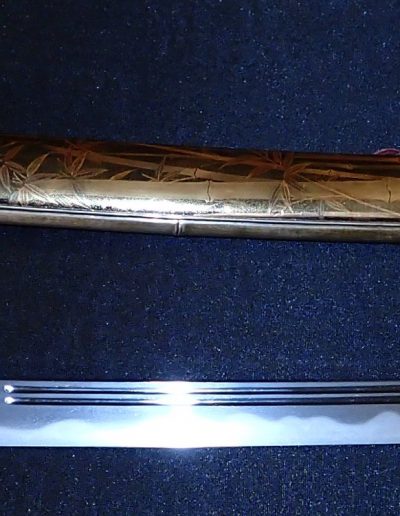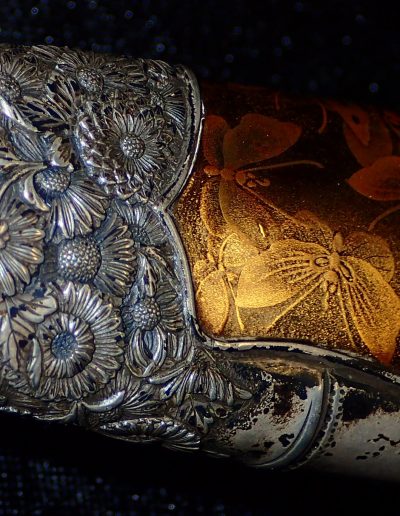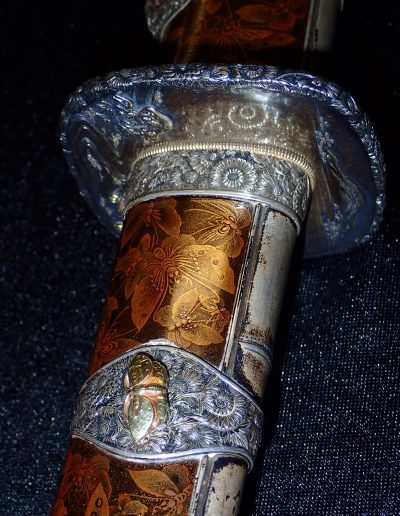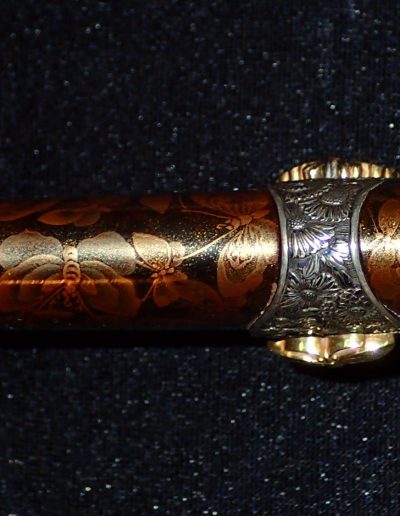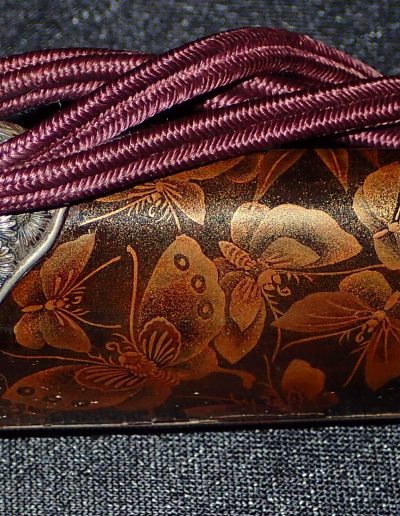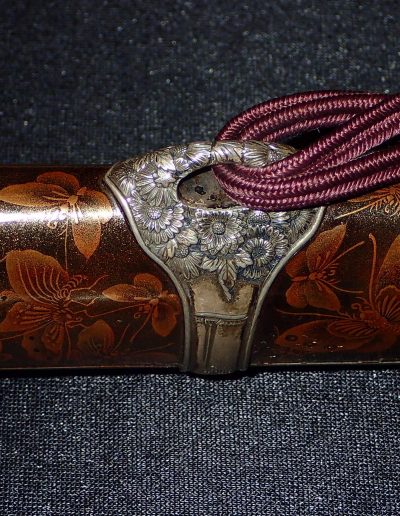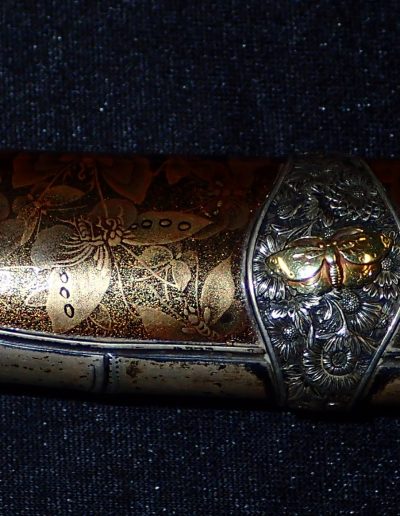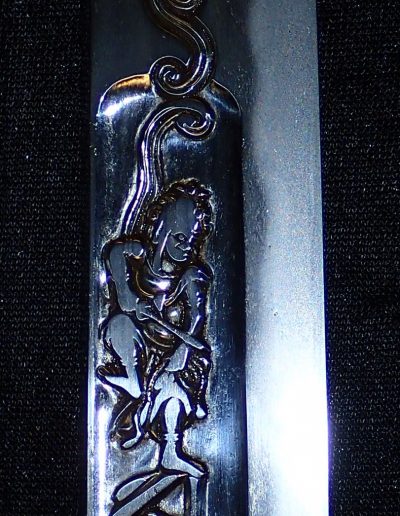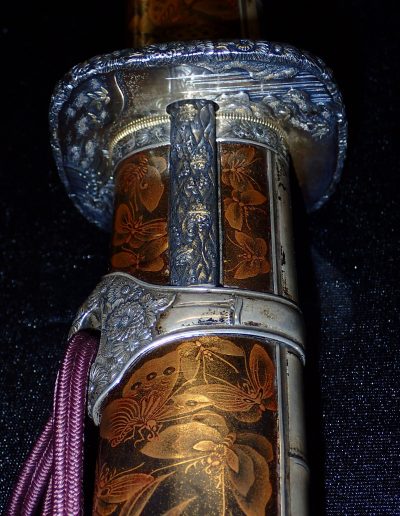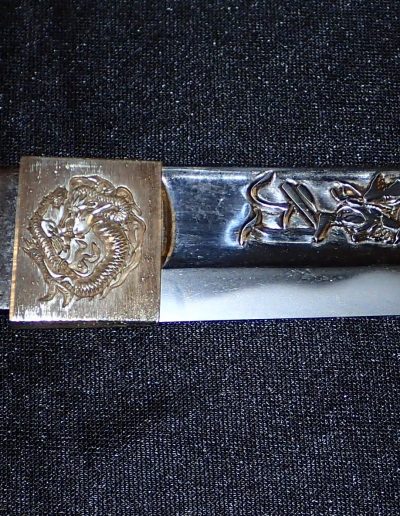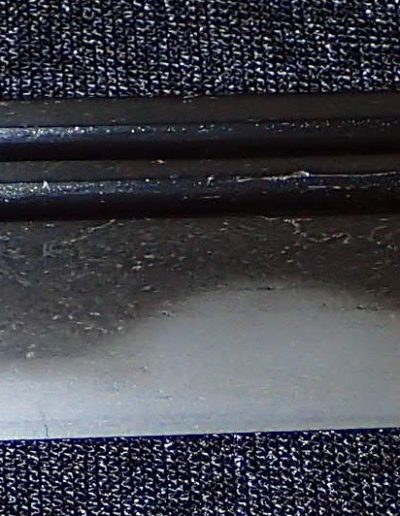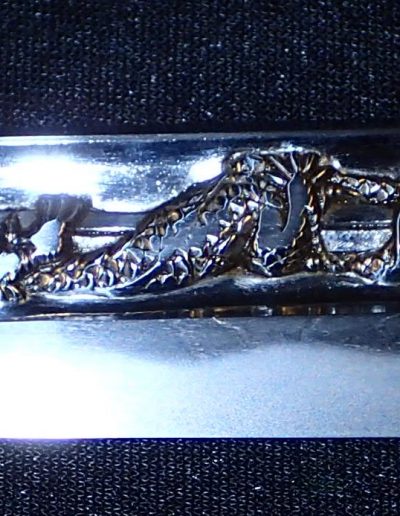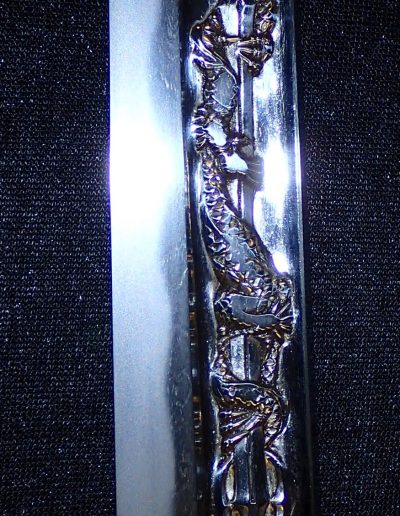Display only
Former display of an Osaka museum
Sanjo Nagayoshi Wakizashi With Ishiguro Koshirae, Nagayoshi was the teacher of Muramasa
Koshirae
Chikurin-gunchō no zu tokidashi makie saya toppei-uchigatana-koshirae
(⽵林群蝶図研出蒔絵鞘突兵打⼑拵) ‒ Toppei style uchigatana-koshirae featuring
saya with polished makie décor of bamboo grove and group of butterflies,
All fittings are solid silver
Fuchi Kashira : Depicting bamboo trunk and closely arranged chrysanthemum
Menuki : Depicting butterflies
Tsuba : Depicting Tiger drinking water ; signed: Tōminsai Ishiguro
Masatsune + kaō (東⺠斎⽯⿊政常「花押」)
Kozuka : Depicting waves and an arrangement of paulownia crests, unsigned
Tsuka : Makie of butterflies and Bamboo
NAGAYOSHI (長吉),
5th gen., Eishō (永正, 1504-1521), Yamashiro – “Heianjō Nagayoshi saku” (平安城長吉作),
“Nagayoshi” (長吉), “Sanjō Nagayoshi saku” (三条長吉作), “Heianjō Nagayoshi” (平安城長吉), “Heianjō Nagayoshi
Sanshū no Kuni saku” (平安城長吉三州国作), “Yoshinori no ko Nagayoshi saku” (吉則子長吉作, “made by
Nagayoshi, son of Yoshinori”), “Sōshū-jū Nagayoshi” (相州住長吉), we know date signatures from the third year of
Bunki (文亀, 1503) to the 13th year of Eishō (1516), he mentions in his signatures that he was the son of Yoshinori
whereas probably the Bunmei-era (文明, 1469-1487) Sanjō Yoshinori (三条吉則) is meant, during his early years he also
worked in Mikawa, Ise, and in Sagami and there exists the tradition that whilst staying in Ise, he acted as master of
Muramasa (村正), his horimono show an influence of the Odawara-Sōshū school, that means they are somewhat finer and
more detailed as the horimono of earlier Heianjō works, relative many tantō are extant, they measure around 27.3 cm, have
a wide mihaba, and some sakizori, or are with 18.2 to 21.2 cm in length somewhat smaller, have a narrow mihaba, and a
thick kasane, the hamon is a suguha mixed with gunome-midare which gets wider towards their base or which tends to yahazu,
this interpretation reminds of the Sengo school (千子), his ō-gunome-midare on the other hand reminds of the Odawara Sōshū school,
the tang tends to a tanagobara and has a ha-agari kurijiri, the yasurime are kiri and when he signed with a naga mei that mentions the production site, he mostly applied katte-sagari yasurime, jō-saku
42. Sanjō Nagayoshi saku (三条⻑吉作)
We know dated blades from Bunki three (⽂⻲, 1503) to Eishō twelve (永正, 1515) by this smith.
Nagayoshi (⻑吉) was the son of Sanjō Yoshinori (三条吉則) and it is said that he trained in his
early years with Muramasa (村正) in Ise province. However, the horimono seen on his blades
suggest that he also learned from an Odawara-based master. Nagayoshi made relatively many
tantō and either hardened a suguha with a prominent koshiba or a midareba with yahazu elements,
both variants showing an influence by the Sengo (千⼦) School. For Odawara-Sōshū in turn speak
his interpretations in ō-gunome-midare but his tanagobara-shaped nakago again speaks for Sengo
influence.
42. wakizashi, omote-mei: Sanjō Nagayoshi saku (三条⻑吉作), nagasa 55.4 cm, sori 1.0 cm, mid-Muromachi period
Ishiguro Masatsune (石黒政常),
1st gen.
Masatsune – his first name was „Zenzō“ (善蔵) followed by
„Shūsuke“ (周助) – was the founder of the Edo Ishiguro school. He was
born in the tenth year of Hōreki (1760) and studied initially under Katō
Naotsune (加藤直常, see chapter 16.6). Before that he was also taught
for a certain time by Naotsune´s master Yanagawa Naomasa. When he
became independent he took a character from each of his masters,
namely „tsune“ (常) from „Naotsune“ and „masa“ (政) from
„Naomasa“ and combined them to „Masatsune“. With his extraordinaly
skill he was able to give the Ishiguro school a strong position in the
system of the Yokoya lineages. His harmonic balance between motif
and shape of the piece was highly appreciated, as was his perfect
nanako. The strong point of the Ishiguro school were interpretations of
birds combined with floral motifs, the so-called subject of „kachō“
(花鳥), whereas most works were done in shakudō with nanako ground
and a takabori-iroe ornamentation. At the age of 61 he took the gō
„Jumyō“ (寿命). In his early years, when he studied under Naotsune, he
also signed with „Koretsune“ (是常) and other pseudonyms such as
„Tōgakushi“ (東嶽子 or 東岳子) – of which the suffix „-shi“ can also
be omitted – „Sekkokusai“ (石黒斎, which is also read „Ishigurosai“),
„Sekkoku´ō“ (石黒翁), or „Jukokusai“ (寿谷斎). The latter gō and
„Tōgakushi“ were also used by the 2nd gen. Masatsune. Masatsune the
first died in the seventh month of Bunsei eleven (1828) at the age of 69
17.2 Ishiguro Masatsune (石黒政常),
2nd gen.
The 2nd gen. Masatsune was the son of the 1st gen. His first name
was „Taminosuke“ (民之助) and he signed with the name „Masamori“
(政守) from the An´ei (1772-1781) to the Tenmei era (1781-1789).
Before he succeeded under the name of „Masatsune“ he also used
„Moritsune“ (盛常) for a while. His gō were „Tōgakushi“, „Jukokusai“
or „Jukoku“ and „Juchō“ (寿長). His year of birth and death are
unknown.
Ishiguro Masatsune (石黒政常),
3rd gen.
The 3rd gen. Masatsune was the son of Masatsune the second and the
grandson of the 1st gen. He studied first under Ishiguro Masahiro
(政広), a student of the 1st gen. Masatsune, whereas he used the name
„Shigetsune“ (恵常 or 惠常) at that time. His first name was
„Matakichi“ (亦吉) and his pseudonyms were among others „Hōgen“
(抱元), „Hōgan“ (抱完), „Kakujusai“ (鶴寿斎), „Gantōshi“ (雁蕩子),
„Koryūsha“ (古竜舎), „Keiho“ (恵甫) and „Shūsai“ (周斎). He
succeeded as head of the Ishiguro family sometime between the Kōka
(1844-1848) and Kaei (1848-1854) periods and it is assumed that he
was still active in the Meiji era.


